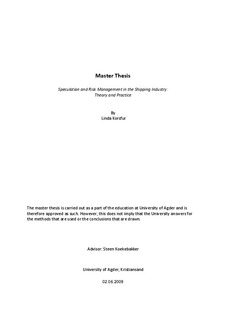| dc.description.abstract | This thesis investigates speculation and risk management in the shipping industry in general
represented by the use of a case study consisting of two dry bulk shipping companies. In
addition, it focuses on the impact of the financial crisis on the dry bulk shipping industry.
Shipping is one of the world’s most international and capital intensive industries, and has
since the very beginning been characterised by cyclicality, seasonality and volatility. Volatility
in general and the recent dry bulk collapse suggest that shipping is a high-risk industry in
which risk management is rather important in order to avoid instability and unpredictability.
There are five main risks that are of vital importance for shipowners and should thus be
managed. These risks include freight rate risk, bunker price risk, exchange rate risk, interest
rate risk and counterparty risk. There are several ways of managing these risks, and the most
common is hedging through the use of derivative contracts such as futures, forwards,
options and swaps. Market participants that actively manage risk with these instruments will
experience reduced costs of financial distress and will be less exposed to short-term
volatility than companies that stay un-hedged. In addition, by exploiting these tools,
companies can obtain a competitive advantage by becoming more suited and prepared for
unexpected ups and downs in the market.
The results of the case study show that the two companies operate rather differently when
it comes to risk management. Where Camillo Eitzen & Co ASA actively implements hedges
against freight rate risk, bunker price risk, interest rate and currency risk, Golden Ocean
Group Ltd does not. The only feature they have in common is that they both operate in the
dry bulk industry and that they both trade Forward Freight Agreements to a certain degree.
Other than that they differ in terms of sub-segment, contract strategy and risk management
strategy in general. What is particularly interesting is that both companies have recently
experienced financial distress, suggesting that implementing an active hedging strategy in
order to avoid financial distress may prove insufficient as long as a global financial crisis
negatively affects all industries. | en |
